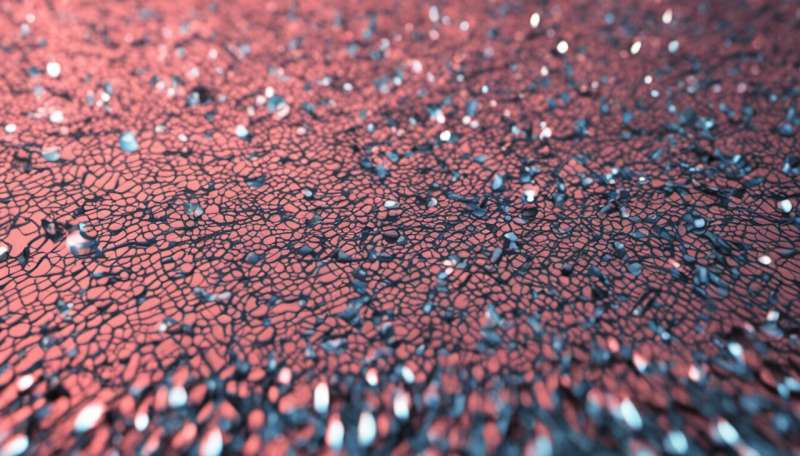Credit: AI-generated image (disclaimer)
Creating the next generation of solar cells and sensors requires a close look at how light interacts with light-responsive materials. Research at the U.S. Department of Energy's (DOE) Argonne National Laboratory is advancing this understanding toward a future with flexible, highly efficient solar cells and cutting-edge optical tools.
To design new technologies that harness light using organic materials, scientists are exploring the basic molecular functions at play. For example, the use of specially designed carbon-based components could enable flexible, thin-film solar cells, or photovoltaics. This type of material could enable everything from tinted power-generating windows to portable chargers, expanding solar energy far beyond traditional, silicon-based roof panels. However, much remains to be discovered about which building blocks for these organic photovoltaics will deliver high efficiency, durability and low cost.
"In some ways, photovoltaics today are like the early auto industry," said Richard Schaller, a physical chemist at Argonne and professor at Northwestern University. "A dozen or more different engineering and materials approaches all aim to utilize solar energy, but they target multiple identified markets, as well as respond to different cost and performance drivers."
Such materials span thick, high-purity crystalline inorganics like silicon to low-cost, much thinner organic plastics and small molecules that need less initial energy input to fabricate.
The heart of organic solar cells is composed of separate regions known as electron donors and electron acceptors. When photons from sunlight hit these regions, the photons deposit energy into negatively charged electrons, which are excited and produce positively charged holes where the electrons were. These electron-hole pairs stick together due to their opposite charge and are called excitons. When excitons meet the interface between donor and acceptor, they can split, facilitating the separate transfer of electrons moving toward one electrode and holes toward the other, generating a current.
Spherical, hollow carbon molecules known as fullerenes make great acceptors within a cell, but fullerenes have drawbacks, said Lin Chen, a Distinguished Fellow at Argonne and chemistry professor at Northwestern University.
"Fullerene is hard to synthesize, and more expensive by weight than gold," she said. "It's been an ongoing process to find non-fullerene acceptors that are cost-effective and robust for long-lasting organic solar cells."
Chen, Schaller and colleagues are studying perylenediimide (PDI) derivatives, which are potential alternatives to fullerenes based on a class of inexpensive pigments. In a recent study, the researchers examined six variations of PDIs synthesized by Luping Yu, a study co-author and chemistry professor at the University of Chicago, and his colleagues. The goal was to see how changes in molecular structure affected the PDIs' light-converting efficiency.
These PDI molecules are linked together into pairs called dimers to enhance their electronic communications with donor materials. The study compared activities among these dimers with linkers of different length and rigidity. The research, which was published in the journal Chemical Science in June, 2020, combined experimental and theoretical expertise among the collaborators to assemble the most comprehensive characterization yet of different PDI structures for photovoltaics.
On the experimental side, researchers examined the dimers with ultrafast emission and transient absorption spectroscopy to measure in real time the dynamics of exciton generation, evolution and decay. These optical studies, which help sensitively track exciton activity by recording different spectra of light as the photons are absorbed or emitted by the material, were conducted at Argonne's Center for Nanoscale Materials (CNM), a DOE Office of Science User Facility.
The time-resolved light measurements were validated via comprehensive calculations by George Schatz, study co-author and a chemistry professor at Northwestern University, who together with colleagues examined the structural dependence of energy levels in these molecules, such as how the linker between two PDIs modifies the density of the electron flow between them.
In a separate study, Chen, Schaller and colleagues evaluated the exciton activity of assembled molecules known as two-dimensional covalent organic frameworks, or 2D COFs, designed by study co-author William Dichtel and colleagues at Northwestern University. COFs have potential for use in light-emitting diodes, chemical sensors and photovoltaics—their geometric precision lends itself to efficient energy transport. But little is known about how electrons actually behave in these emerging materials.
2D COFs resemble snowflakes that can be stacked or linked to create an electron-transporting network. As they join together, their properties change, and the researchers wanted to know why. They inspected these crystalline structures, again using transient absorption spectroscopy at Northwestern University and the CNM and also the DuPont-Northwestern-Dow Collaborative Access Team (DND-CAT) beamline at the Advanced Photon Source, a DOE Office of Science User Facility at Argonne.
Powder scatters light to an extent that makes it difficult to characterize with spectroscopy. To get around this problem, the researchers created a colloidal solution of COFs, allowing for photophysical characterization that wouldn't have been possible otherwise.
"Colloidal COFs are at a pretty early stage," Schaller said. "In the past, they've only been made as solid powders, and so even just studying their properties has been a challenge that William Dichtel has been able to break open."
Spectroscopy was used to gauge electron activity, while the DND-CAT beamline helped measure the size and molecular packing of the COFs' crystalline domain.
"We discovered a very high mobility of excitons in the 2D COFs, which was unexpected," Chen said. "The findings reinforce these structures' promise for potential opto-electronic applications."
The team's results are detailed in the paper "Large exciton diffusion coefficients in two-dimensional covalent organic frameworks with different domain sizes revealed by ultrafast exciton dynamics," which was published last July in the Journal of the American Chemical Society.
More information: Nathan C. Flanders et al. Large Exciton Diffusion Coefficients in Two-Dimensional Covalent Organic Frameworks with Different Domain Sizes Revealed by Ultrafast Exciton Dynamics, Journal of the American Chemical Society (2020). DOI: 10.1021/jacs.0c05404
Journal information: Journal of the American Chemical Society , Chemical Science
Provided by Argonne National Laboratory
























